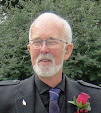
Last October I blogged about a sculpture in the Kelvingrove Museum and Art Gallery in Glasgow to which I took a real fancy. I thought it was one of the most moving sculptures I'd ever seen. As I hadn't made a note of the title nor the sculptor nor could I find any details of it on the Kelvingrove website, I simply called it Father and Child. Two things happened today. I read Simply Heather's posting Cultivating Flourishing Appreciation and Martin came back from Scotland having been to the Kelvingrove and looked up the information for me. The title of the piece is Motherless and it is by George Anderson Lawson (1832 - 1904).
Hugh Stevenson, Sculpture Curator, kelvingrove Museum and Art Gallery has said of the piece on the Relicarte website:
The heart-rending sculpture by George Lawson has been a firm favourite among visitors since being bought for Kelvingrove in 1901. The story behind the ensemble of the sad little girl in the arms of her distraught father needs no explanation apart from the title Motherless. One can only speculate how mother met her end – in a tragic accident perhaps, or in one of the epidemics that swept Victorian Britain.The popularity of this piece is guaranteed by its appeal to the emotions. It is by far the best-known work by Scottish sculptor George Lawson; in fact it is probably the only work known to most people by the man who was responsible for the figure groups on the front of Glasgow’s City Chambers.
What is the relevance of Heather's posting and and why did it prompt this posting? The fact that she had found a wonderful statue of a child.
Life is just so full of coincidences.





I saw a sculpture of the Motherless Child in a Pittsburgh cemetery. It was done in black and on the side was inscribed C.S. Lawson 1897. Seems a mystery, as the only link is this site for George Lawson. Any information would be appreciated. Send to michellevmcrae@gmail.com
ReplyDeleteIt's the same sculpture, the one in the cemetery in bronze. And the initials are G. A. Lawson. It's in front of a Mellon mausoleum. I suspect there is a family story there.
ReplyDeleteFurther note from another website:By some standards the richest family in the world, the Mellons preferred good taste to ostentation in this simple Doric temple, built for James Ross Mellon, who died in 1934. The sculpture in front, “Motherless” by George A. Lawson (1897), actually doesn’t memorialize any particular dead Mellon; it was a piece of garden statuary that James Ross Mellon liked, but his heirs didn’t want in their garden.
ReplyDeleteFirstly Michelle I apologise for forgetting to respond by email to your comment of 26 November. As it happens I had no other information.
ReplyDeleteSecondly thank you and Don for that information I certainly couldn't find any other information when I wrote the post although I stop by the plaster sculpture every time I go into the museum.
Just wanted to flag how moving I felt when I was working in KG for a while in 2014. It was always intriguing. Thanks for posting.
ReplyDeleteIt's good to read how you felt Craig.
DeleteThe curator misses the point entirely. The likely cause of the mother's death is neither accident or disease but childbirth.
ReplyDeleteHere is a father, ill equipped for sole responsibility for the upbringing for 21 years of a daughter now on the cusp of puberty. As his daughter becomes an adult, she daily reminds him of his late wife. He made his wife pregnant and the outcome is his present situation.
Till the 1920’s, maternal death rates were high, particularly in poorer communities. An old Red Clydeside politician [Manny Shinwell?] said that in his early years in Glasgow, he met a lot of single parent families. They were all men.
John I hadn't given any critical thought to the curator's statement. What you say certainly feasible and convincing.
DeleteI saw this statue in Glasgow but unfortunately my camera was not as good as yours. My mother died (in childbirth) when I was eight and my father in his 30's. My father is of Scottish descent and the man in the statue looks like him. When I visited the museum the statue was at the top of the stairs of the museum. Took my breath away. So glad you posted this picture.
ReplyDeleteI'm pleased that you are enjoying it, Old Math Teacher. I assume from the use of 'Math' in the singular and your reference to your father being of Scottish descent, that you are not resident in the UK. Thank you for letting me know.
Delete